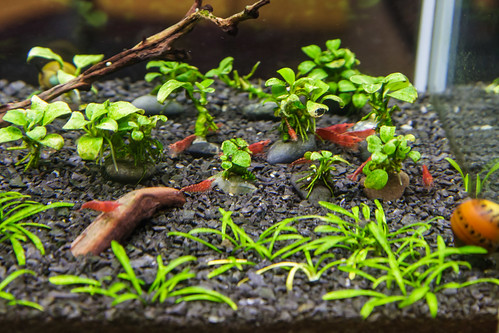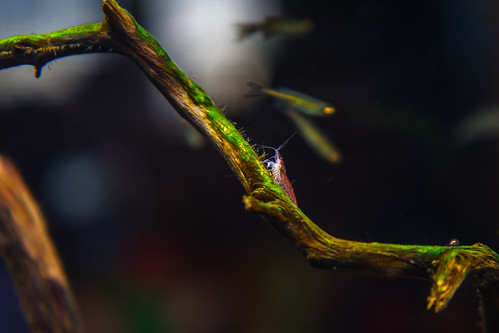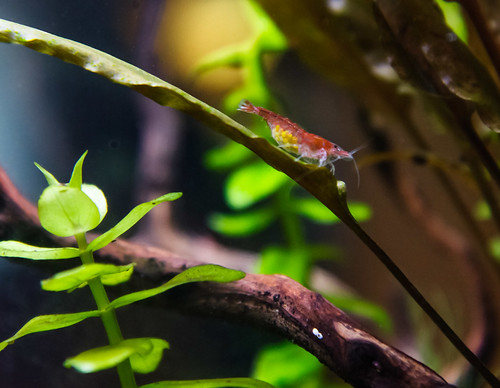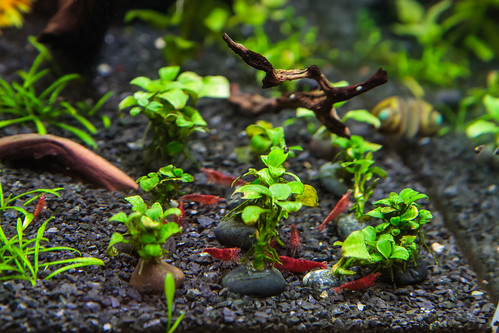When setting up our little nano planted aquarium, I wanted to make it home to some shrimp. It was something new and challenging that I had not tried in my previous childhood aquarium. I am so glad that we got them into our Spec V – they have become the star occupants of our aquarium!
Being something new, I was a bit aprehensive about housing them, but it turns out that Red Cherry Shrimp (RCS) are quite hardy and easy to keep. I am also discovering they are very prolific in reproducing! Breeding red cherry shrimp is very simple and is as easy as getting some males and females into a hospitable environment and letting them do their thing.
Making a Good Home for Red Cherry Shrimp:
To breed Red Cherry Shrimp, you first need to make a good home for them. This is really simple and is no different than any other fish or invertibrate you house in an aquarium.
Shrimp in general like clean, filter water. It doesn’t take anything fancy, just decent flowrates and a good filter with plenty of surface area for beneficial bacteria. If you do this, and you properly cycle your aquarium, then you should have a tank with no ammonia, no nitrites, and low nitrates. To keep the water conditions ideal, perform a weekly partial water change to keep the Nitrates from accumulating. Housing plants with the shrimp is not required, but highly recommended. Shrimp naturally feed off soft algae, bio-film, and decaying plant matter, so plants will help give them more surface area and options for feeding. Plants will also give them coverage to hide so they will feel more secure from other tank mates.
Red Cherry Shrimp, unlike other more finiky breeds like Crystal Red Shrimp (CRS), can survive in a wide range of temperatures. Around 72°F up to around 81°F is fine for RCS. That is quite a wide range and should offer plenty of room to find a compromise between them and other tankmates. 76F is where I have my aquarium set at the moment and they are healthy and active at this temperature. Likewise, Red Cherry Shrimp can survive in a wide range of PH water conditions. As best I can tell, anywhere in the ph range of 6.0 up to 8.0 will be fine. In my non CO2 injected tank that i fill with tap-water stays around 7.5ph and this has worked out great. Red Cherry Shrimp do better in slightly hard water as this helps with the development of their exoskeleton as they grow.
Before you decide to put some RCS in your aquarium, you have to consider the risk of predators. Red Cherry Shrimp make for a great snack for many fish, so it’s important to be realistic about what other fish are in your tank. If a fish can fit a shrimp in their mouth, they will eventually have one as a snack. For the aquarium with shrimp, it is best to stick with smaller fish that would be suitable for a nano aquarium.
Even with careful selection of tank mates, you should realize that when a shrimp does have babies, they will be out on their own and they are very small. Even nano fish will snack on baby shrimp if given the opportunity. The only way to reduce the losses from consumption by fish is to try and make some hiding places in the tank as refuges.
As I mentioned previously, plants help out greatly as the baby shrimp can graze below some carpeting plants and stay under the radar. In addition to plants, try to find rocks or driftwood pieces that have holes in them for shrimp to hide. I have a small driftwood piece in the center of our nano aquarium that features a small tunnel. Fish won’t go in because it is too small, but shrimps and their young are always hanging out in there. These hiding places helped our first brood of young shrimp to survive even with other fish sharing their very small aquarium.
Red Cherry Shrimp can live on the natural biofilm of an established tank. However, as they increase in number and size, it is good to supplement their food. I provide a few granuals of Hikari Shrimp Cuisine every night or two.
Red Cherry Shrimp: How to Tell the Males from the Females
Again, to breed Red Cherry Shrimp, all you need are males and females in one tank and a safe environment. They will reproduce. How do you tell the males from the females?
It’s tough for shrimp that are juviniles. I purchased young shrimp at a good price, so I wasn’t sure what I had. In my case, I bought 6 hoping that there was a good mix of males and females. It turned out well and there was indeed males and females in the group.
When they get older and bigger, the males and females are fairly easy to distinguish. Males are generally smaller and have a less vibrant red color. If you see an RCS that has a slight red/clear striping, it is most likely a male. Females are conversely larger and sometimes have more intense red coloration. The real distinguishing charactoristic for females is a yellow or green patch on their back. When you view a mature female shrimp from the side, the eggs are visible in their ovaries. This is referred to as the ‘saddle’ as it is roughly in that location on their back.
Mating, Pregnancy, and Early Development
When a male and female mate, the fertilized eggs in the saddle will move down from the location on the back to the female shrimp’s underbelly. This is where things get fun as the eggs get larger and larger. As the eggs mature, they can be seen moving as they cling to the underside of the female. In this state, the female is said to be ‘berried’. The baby shrimp eggs are actually not inside the female at this point, but are clinging onto her ‘swimmerettes’. She will constantly fan them with fresh water so that they can transfer oxygen and remain healthy. The baby shrimp hatch from the eggs as tiny, fully functional shrimp.
About the only thing that the young shrimp need is a source of food and protection. They will mainly be able to sustain from the natural bio-film in a well established aquarium. I have already established the main need for protection and that is to provide hiding places for the young and to only house with peaceful, small fish. Even then, there will be some losses through predators; however, some should survive and make for many generations of RCS.
One special consideration to protect your new baby shrimp is the filtration system in your aquarium. The baby shrimp are tiny and easily sucked into the filtration system of some aquariums; they might not survive a trip through the pump so this is to be avoided. The solution depends on your aquarium, but will generally be solved with some sponge filter material to keep the babies out of the filter intake. On a Fluval Spec aquarium, you can fit some sponge filter material over the outside of the overflow slots and either hold in place with the acrylic cover or tie down with some zip ties. You can also make your own overflow cover out of stainless steel. I tried to block them out of the filter section with a sponge, but then removed it and didn’t notice any loss of baby shrimp. I observed them swimming into the filter section through the grates, and then swimming right back out.
I have heard it suggested that the very best filtration system for a small shrimp aquarium is sponge filters. These draw water through sponge material using air (from an air pump). This would be useful for a tank that housed valuable baby shrimp that were prized.
One thing to keep in mind for the long term health of a Red Cherry Shrimp colony is that over time, they become weaker genetically because of inbreeding. It is a good idea to give some of your RCS away to keep the numbers in check and also to get some RCS from another source to reinvigorate the genetic pool.
From the six RCS that we started with, they have grown to around 30 in only 10 months. They are a great source of entertainment and enjoyment for us. I would get rid of the fish before I got rid of these Red Cherry Shrimp.
This is somewhat of a silly article. It’s like an instructional on how to breed rabbits or cats. You can breed red cherry shrimp by following these simple guidelines: good (consistent) water quality, provide with hiding places, supplement with a good food.








Hey there,
I have a small colony of dwarf shrimps in my Fluval Spec tank II (about 2-2.5G? give or take) and I’m noticing that they all tend to hang out under the sponge filter. At first I didn’t give it much thought and just figured that they were picking scraps off of it but I’m wondering if it’s possibly because of the lack of flow and oxygen. I’ve modified the flow tube and put it on the lowest setting because I had originally intended that tank for a single betta (but got shrimps and some mystery snails for that one and 2 African Dwarf frogs and 3 White Cloud minnows for my other Fluval Spec III, go figure…).
I’m a complete newbie to aquariums and don’t know even the basic functions of how an aquarium really works (just general basics and stuff I’ve researched). The flow out-take tube where I’ve stuck the sponge is only an out-take of water into the main body of water, right? Would any shrimp babies be sucked in if I remove the sponge? 🙁
I have used a similar setup with a sponge over the return outlet nozzle and did not notice any similar behavior in my shrimp. Try removing the sponge and seeing if their behavior changes. No, removing the sponge from the outlet nozzle will not ‘suck’ anything in. Water flow is outwards and they can’t traverse that strong of a velocity.
For a 2.5 gallon originally intended to hold 1 betta it might be over crowded. They recommend 5 shrimps per gallon of water and that is assuming if you only have shrimp. The 3 White Clouds alone would require at least a 5 gallon tank by themselves.
I am keeping dozens, possibly a hundred or more RCS, in a fluval edge 6. For over a year they have been doing great, continuing to breed constantly. The are healthy and happy.
The tank also has several nano fish.
I change about half the water every week or two, and trim the rapidly growing plants. I wash filter media once per month or so.
That is the entirety of my tank maintenance.
On rare occasion (once every few months, if that) I have scraped the glass for algae, but algae is never really an issue.
Shrimps contribute such tiny amounts to a tank’s bio load (white helping to clean the aquarium) that the five shrimp per gallon thing just doesn’t apply.
Not sure where that info came from, but it certainly doesn’t apply in my tank.
I’ve moved the sponge and found that my berried female was busy when a cloud of shrimp babies(?!) flew off from it. The shrimp are still on it and I’ve concluded that they just love picking food off of the sponge lol.
Yeah, my Fluval II and III are overstocked. The frogs seemed happier when they were by themselves in the Spec Tank II without the minnows going crazy above them. I’m giving away my minnows to a friend and transferring my frog and the snails to my incoming Spec V and convert the Spec III into another shrimp tank. Whew, so many different dynamics even with research and hear-say.
Thanks for the help, guys!
First I want to say thank you for this great information across your site for our Spec tanks. My question doesn’t pertain to cherry shrimp although I do have some in my SpecV. My Platy has given birth to some Fry and I figured they were all eaten by the mother or father because I have only seen one for the past two weeks or so. I just went to clean my filter and I noticed that there are about 6-10 fry in the filter and pump compartment and I cannot get them out of there. I unfortunately didn’t cover the slit at the bottom when I set up the tank. I have tried to vacuum them out and tried to bet them but the little buggers are too fast and the space is so small. Any ideas on what I should do to get them out of that space? If I cannot get them out I suppose the only option is wait for them to pass and then vacuum out the bodies? Idk what to do and I feel terrible about there precarious situation. . Any help is greatly appreciated. Thank you again.
I can’t offhand think of how to get those babies out of the filter section. Maybe a very small net and much patience? I’d suggest blocking the entry in the future with either the stainless steel mod or a piece of sponge.
Indian almond leaf added to the tank started killing my shrimp and dropped my pH to 6.0, I hope no one else makes this same mistake. A lot of people online say to add these. I found out the hard way and lost 3-4 bloody mary shrimp.